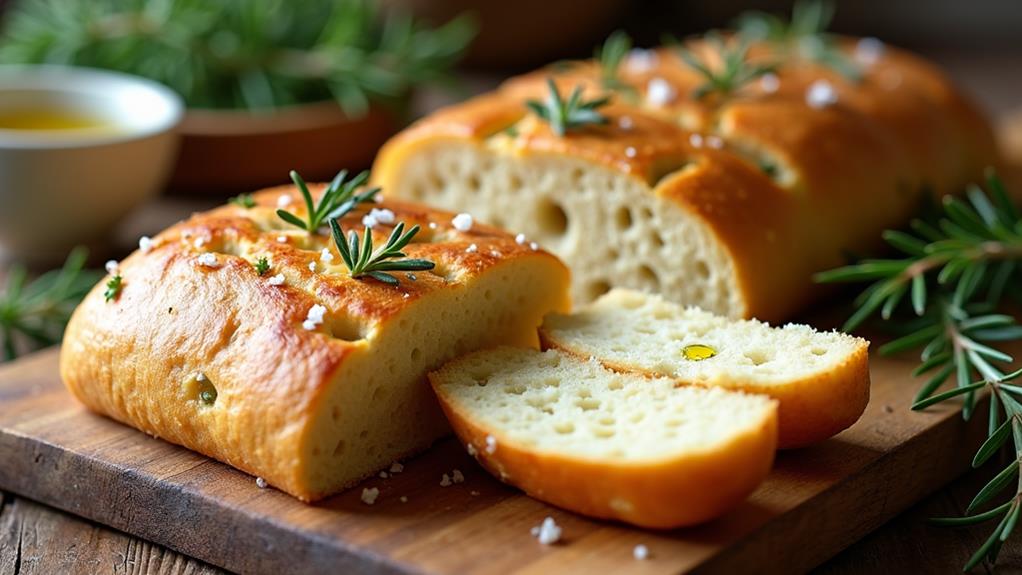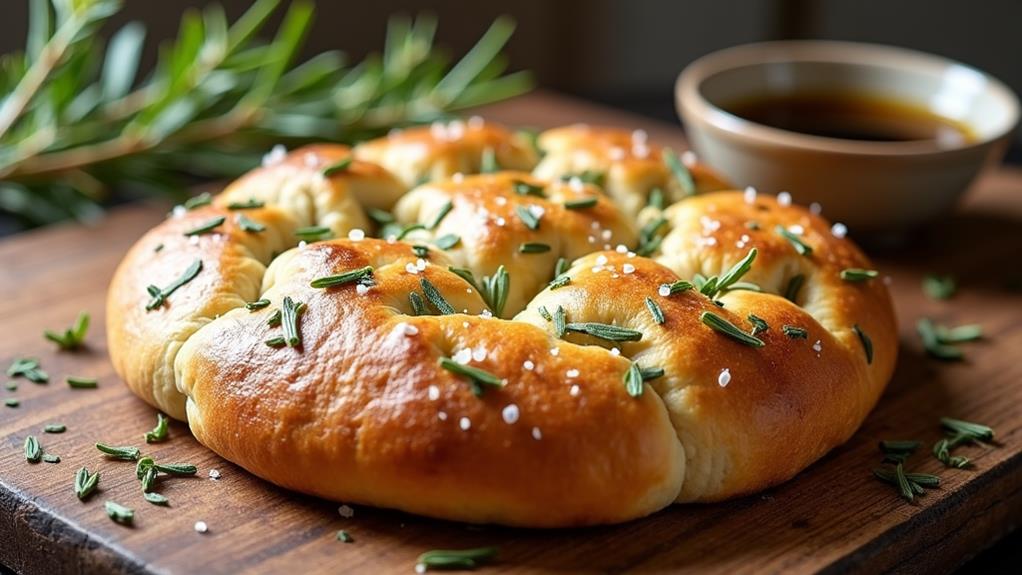When you think of Italian cuisine, rosemary focaccia often stands out as a timeless staple. Its soft texture and aromatic flavor make it a versatile choice for any meal. The history behind this flatbread reveals fascinating regional variations and a rich culinary heritage that dates back to ancient Rome. As you explore its preparation methods, you might find that the simplicity of the ingredients belies the depth of flavor it offers. What if you could elevate your focaccia game even further with unique toppings and techniques? The possibilities just might surprise you.
History
Exploring the history of rosemary focaccia reveals its deep roots in Italian cuisine. You might be surprised to learn that this delightful bread has ancient origins, dating back to the times of the Romans. They often made flatbreads topped with olive oil and herbs, showcasing the simple yet flavorful ingredients of the region.
As you dive deeper, you'll discover that rosemary focaccia isn't just one recipe; it comes with regional variations that reflect the unique flavors of different Italian areas. In Liguria, for example, you'll find a slightly thicker version, while in Tuscany, it might be baked with a crispier crust. Each region adds its own twist, making every bite a journey through Italy's rich culinary landscape.
When you serve rosemary focaccia, you're not just sharing bread; you're offering a piece of history, a taste of tradition. Imagine your guests gathering around, enjoying the warm, fragrant bread with olive oil for dipping, or using it to soak up delicious sauces.
It's more than food; it's an experience that brings people together, making every meal special and memorable. So, get ready to delight your loved ones with this timeless Italian classic!
Recipe

Rosemary focaccia is a delightful Italian bread known for its soft, airy texture and rich flavor, enhanced by the aromatic essence of fresh rosemary. This versatile bread can be enjoyed on its own, dipped in olive oil, or used as a base for sandwiches. The key to a perfect focaccia lies in the dough's hydration, which contributes to its signature lightness and chewiness.
When baked, the bread develops a crispy, golden crust while remaining tender inside, making it an irresistible addition to any meal.
Making rosemary focaccia at home is easier than you might think. With simple ingredients and minimal effort, you can create a fragrant loaf that fills your kitchen with the warm aroma of freshly baked bread. It's perfect for serving alongside soups, salads, or as an appetizer. You can even customize your focaccia by adding toppings like olives, sun-dried tomatoes, or garlic to suit your taste.
Ingredients:
- 4 cups all-purpose flour
- 2 teaspoons instant yeast
- 2 teaspoons salt
- 1 ½ cups warm water
- ¼ cup olive oil (plus extra for drizzling)
- 2 tablespoons fresh rosemary (chopped)
- Sea salt (for sprinkling)
Instructions:
In a large mixing bowl, combine the flour, instant yeast, and salt. Gradually add warm water and olive oil, mixing until a sticky dough forms. Knead the dough for about 5-10 minutes until smooth and elastic.
Place the dough in a lightly oiled bowl, cover it with a damp cloth, and let it rise in a warm place for about 1-2 hours, or until doubled in size. Once risen, punch down the dough and transfer it to a greased baking sheet. Press the dough into a rectangular shape, dimpling the surface with your fingers.
Drizzle with olive oil, sprinkle with chopped rosemary and sea salt, and let it rise for another 30 minutes. Preheat the oven to 425°F (220°C) and bake the focaccia for 20-25 minutes or until golden brown. Allow it to cool slightly before slicing.
Extra Tips:
For the best flavor, use fresh rosemary and allow the dough to rise in a warm, draft-free environment. You can also experiment with different herbs such as thyme or oregano, and don't hesitate to add toppings like sliced olives or cherry tomatoes for a burst of flavor.
If you prefer a more pronounced crunch, bake the focaccia directly on a preheated baking stone or a cast-iron skillet.
Similar dishes include ciabatta, which also boasts a chewy texture, and focaccia variations such as focaccia barese, which incorporates potatoes into the dough for added moisture. Herb-infused breads like garlic bread or even pizza dough share some fundamental similarities with focaccia, making them great alternatives for those craving a delicious, homemade bread experience.
Final Notes
Once you've mastered the art of making rosemary focaccia, there are a few final notes to keep in mind for the best results. First, always let your focaccia rest after baking. This allows the flavors to settle and the texture to improve, making it even more delightful for your guests. You can also drizzle a little extra olive oil on top before serving to enhance that beautiful, rich flavor.
When it comes to baking tips, don't be afraid to experiment! Focaccia is a versatile bread that welcomes different flavor variations. Try adding sun-dried tomatoes, olives, or even a sprinkle of cheese to the dough before baking. Each addition can transform your focaccia into a unique treat that'll impress everyone at your table.
Lastly, remember that the key to great focaccia is patience. Letting the dough rise properly will guarantee it's light and airy.

